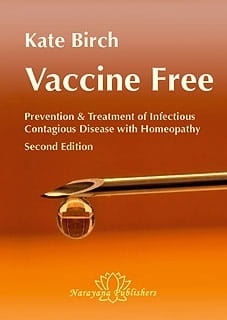A Manual for Practitioners and Consumers - Second Edition
A practical handbook for the homeopathic treatment and prevention of infectious disease. Kate Birch, a mother of two, saw her son fall ill with asthma after being vaccinated. Following the successful homeopathic treatment of her son, she decided to become a homeopath herself and to find alternatives to vaccination.
In this book, she provides a clear introduction to the basic principles of homeopathy as well as a comprehensive overview of the known infectious illnesses and their pathogens, the usual vaccinations and treatments, together with the possibilities of homeopathic prophylaxis and therapy. This includes – along with the well-known childhood diseases such as chickenpox, measles, rubella, otitis media, and scarlet fever – the common infectious diseases such as influenza, mononucleosis and pneumonia, as well as infections such as rabies, tetanus, diphtheria and tuberculosis. There is also a comprehensive section on sexually transmitted diseases, including herpes, gonorrhoea, syphilis, AIDS and hepatitis. Tropical diseases such as yellow fever, dengue fever, malaria, and typhoid fever are covered in detail. An extensive section deals with the various forms and homeopathic treatment of fever, and there is also a chapter on the adverse effects of vaccination and their treatment.
It is the first manual of its kind, which not only draws attention to the potential ill effects of vaccinations, but also describes the alternatives in a thorough and easily understandable way. A truly all-inclusive book on a highly topical issue.
"Not too many details here but not bare bones either, Kate Birch has found the almost perfect presentation of the necessary information. I really appreciated the practical usefulness of the information provided. We all meet concerned parents who hesitate a lot about what to do about vaccines; this book will give correct and concentrated information. I strongly recommend it to each and every practitioner."- Dr. J. Rozencwajg, Homeopathic Links
- Author: Kate Birch
- ISBN: 9783941706279
- 389 pages
- Edition: Second
- Hardback
- Published in 2012
- Printed in Germany
Review published in Spectrum of Homeopathy, January 2010 - Petra Wood, UK.
At last! A complete reference textbook on contagious diseases, and a must for those sticky issues around vaccinations, written for homeopaths and lay-people alike.
This book is a monumental work on vaccines and vaccination issues (damage and alternatives), and addresses the widest range of infectious and contagious diseases.
The first five chapters explain the basic philosophy of homoeopathy in 60 pages. It is one of the best introductions to homeopathy I have come across. The author covers the concepts of vital force, the immune system, and miasms and nosodes in a succinct, yet very understandable language, making the text accessible not just for homeopaths but for lay-people alike. The author‘s passion for homeopathy shines through her words. References to the Organon are made throughout the book, which gives the reassuring feeling that the author knows her philosophical roots.
One chapter is dedicated to homeoprophylaxis, explaining its roots with Hahnemann‘s own prescriptions. Dr Isaac Golden‘s work in this field is analysed and the guidelines for his prescription strategy are given in a very accessible way.
Another chapter deals with vaccine injury; its treatment with homeopathic remedies and its prognosis in homeopathic terms.
The main part of the book, where diseases are dealt with individually, follows on. The number of diseases included in the book is extremely comprehensive, with conditions ranging from the usual childhood illnesses to tropical diseases, from tuberculosis to gonorrhoea, syphilis and AIDS. The diseases, which form the basis for the miasms (gonorrhoea, tuberculosis and syphilis) are described in a way that gives a deep understanding of the miasmatic background of chronic disease. The chapter on AIDS offers some interesting speculations on the reasons of its rapid spread. (Cancer is dealt with in the appendix, as it is not a contagious disease.)
Each disease is described with its origins and symptoms, followed by conventional vaccines and treatment. Next comes a comprehensive list of homeopathic remedies, both prophylactic and for treatment once the symptoms have developed. More detailed Materia medica information is given for the main remedies, enabling the reader to make a differentiated choice. Even though many remedies feature for several diseases, each entry is always centred on the disease discussed. Studying the whole book provides, therefore, a good Materia medica knowledge of major and minor remedies.
Throughout, the author points out the need for individualising symptoms and potency choices. She stresses the need for healthy expression of disease and miasmatic tendencies, and gives prognoses that help the reader understand what to expect; a temporary rise of fever or the appearance of an eruption, for example.
The author emphasises the understanding of susceptibility as a means to find remedies to support the individual. Since many of the diseases discussed are epidemic, the susceptibility of the whole society, at the time, needs to be taken into account. The chapter on cholera is particularly explicit here; describing the situation in revolutionary and post-revolutionary France (a time of major cholera outbreaks) she likened the mental and emotional state of the main cholera remedies (Cuprum, Camphora and Veratrum album) to the state of society.
This book is a must for any parent concerned about the issue of vaccination and wanting to be confident in providing homeopathic support and alternatives for their child, as well as for any homeopathic practitioner, who see children as part of his/her practice.

